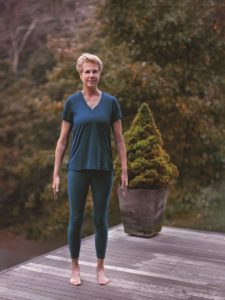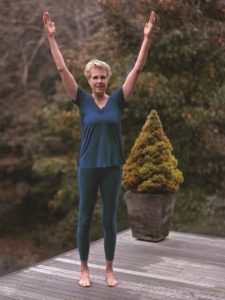At first glance, Mountain Pose, or Tadasana, as it’s known in Sanskrit, looks simple. One just stands there, right? On closer inspection, there are many things happening in this foundational standing pose.
Its many benefits speak to why it is an important one to practice. Mountain Pose strengthens the legs, feet, buttocks, back, shoulders, arms, and neck. It can also reduce stress and improve breathing.
And it is relatively easy to practice. Alongside all these good things, there are a number of things that can go wrong in Mountain Pose. It is a pose to do with attention to your alignment and posture.

To begin, stand with your feet hip width apart. This is generally 6 to 8 inches, but another way to check your alignment is to draw an imaginary line from your hip bones down to your ankles: your ankles should be directly below your hip bones. If this is uncomfortable to you or makes it hard to balance, try taking a wider stance.
Press down through your feet, keeping your weight even on the inner and outer edges of both feet. Notice the balls of your feet and press down on their full width, from the big toe mounds to the pinky toes. Then press your heels into the floor and raise the arches.
From here, feel your body extend from the feet up into the legs. Get long through the legs. Contract and lift the muscles above the knees. Draw the tailbone down and your pubic bone up as you draw your navel towards your spine. Make all these adjustments gently, without forcing or straining.
Now, lift your sternum. Get long through the side body. Lift your head up and out from your shoulders. Feel the crown of the head floating up. Check to see if your chin is jutting forward; if so, draw it back slightly so your head is more in line with your spine.
Where are your arms? Start with them extended down by your sides, hands relaxed but alert, palms open, fingers stretching towards the ground.
Take a deep breath in while raising your shoulders to the ears, hold them there and hold your breath to the count of five, then let your breath go and your shoulders drop. Feel the release of tension.
You are there. Gaze ahead and hold the pose — but don’t hold your breath — to the count of 10.
There is a next step in Mountain Pose, as long as you don’t have high blood pressure or a heart condition. (If you do, practice the pose without raising your arms.) Inhale deeply and raise your arms, palms facing each other. Extend them up into a “V” shape, relax your shoulders, and lift from the armpits. Continue to breathe deeply in and out, feeling your breath as it fills and leaves your lungs. Gaze ahead and stay in the pose to a count of 10, breathing naturally.
On an exhalation, turn the palms away from each other and float them down.
Notice how you feel. Has the pose shifted your awareness of any parts of your body? How is your mood?

Mountain Pose can be illuminating because it increases body awareness — the feeling of connection to your body. Some people say it makes them feel more three-dimensional. You may notice different sensations as you adjust into the pose, though, and some people feel numbness or discomfort as they become aware of a particular part of the body. It helps to breathe and be curious about those sensations.
There is room in yoga to adjust your position for comfort. A good teacher can help you make even big adjustments. For example, you could do this pose in a wheelchair or seated, grounding yourself through the sitting bones rather than the feet.
Always be kind to yourself. You are on a journey of befriending your body.
Mountain Pose, in particular, gets me thinking about my feet and how important they are in supporting me through life. They have evolved to hold us up in our uniquely human stance. And they are amazing structures designed to help us reconcile and neutralize all the movements and forces we encounter day to day.
With our less-active lifestyles, however, our feet can get stiff. Yoga poses done barefoot can help to restore the strength and natural intelligence of our feet to better support us. If you find it hard to tell the different parts of your feet what to do, however, don’t worry — this is where being kind to yourself comes in. We build body awareness with intention and attention. The saying “where attention goes, energy flows” applies here. With practice, you will reconnect and become more familiar with your body.
We all need a pose that can help us stay strong and connected with ourselves and to practice using kindness and curiosity to help us stay the course.
Jennifer Shannon is a certified Kripalu yoga teacher who lives in Truro.



